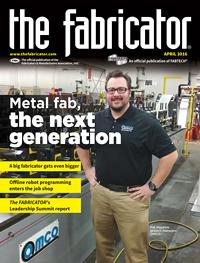Editor-in-Chief
- FMA
- The Fabricator
- FABTECH
- Canadian Metalworking
Categories
- Additive Manufacturing
- Aluminum Welding
- Arc Welding
- Assembly and Joining
- Automation and Robotics
- Bending and Forming
- Consumables
- Cutting and Weld Prep
- Electric Vehicles
- En Español
- Finishing
- Hydroforming
- Laser Cutting
- Laser Welding
- Machining
- Manufacturing Software
- Materials Handling
- Metals/Materials
- Oxyfuel Cutting
- Plasma Cutting
- Power Tools
- Punching and Other Holemaking
- Roll Forming
- Safety
- Sawing
- Shearing
- Shop Management
- Testing and Measuring
- Tube and Pipe Fabrication
- Tube and Pipe Production
- Waterjet Cutting
Industry Directory
Webcasts
Podcasts
FAB 40
Advertise
Subscribe
Account Login
Search
FMA Annual Meeting: Navigating into metal fabricating’s future
Business leaders discuss how skill and technology support success
- By Dan Davis and Tim Heston
- April 13, 2016
- Article
- Shop Management
In late February, standing on the deck of the USS Midway, relishing the near-perfect weather in San Diego, a tour group from The FABRICATOR’s Leadership Summit observed their surroundings with awe and appreciation.
Their guide, a Navy veteran himself, described the organized chaos of life on deck of the aircraft carrier: how everyone really can’t hear each other, but by looking at their color-coded uniforms, they know exactly where they and others need to be at specific times; how landing on an aircraft carrier (which isn’t landing per se but flying at a different altitude before the plane’s tailhook catches) exemplifies incredible piloting, while the takeoff exemplifies incredible engineering (see Figures 1 and 2).
All this is an apt metaphor for life in modern manufacturing. Some parts of the operation require incredible engineering. As the docent explained, in reality, it doesn’t take much skill for a pilot to take off from an aircraft carrier; how smooth or rough it is depends on the design, engineering, and maintenance of the catapult. But if you don’t have skill and thorough training, good luck trying to land.
World-class manufacturers share similar attributes. They employ incredible manufacturing technologies (the catapult) that help their businesses get to the next level. But good luck sustaining it without smart operational strategies that are clearly documented and communicated (like the color-coded team on the carrier deck). And without the right people with the right skills (a pilot bringing in the plane for a landing), a manufacturer can crash in a hurry.
This message held true at the 11th annual FABRICATOR’s Leadership Summit in San Diego Feb. 24-26. The conference, held in conjunction with the 20th annual Toll Processing Conference, was part of the Fabricators & Manufacturers Association (FMA) Annual Meeting, which drew more than 250 metal fabricators and processors from across the country.
Keys for Rapid Growth
Bob Kamphuis, CEO of MEC Inc., The FABRICATOR’s 2016 Industry Award winner, opened the Leadership Summit with a presentation on just how the Mayville, Wis.-based contract fabricator, with 17 facilities in five states, grew so rapidly during the past decade (see Figure 3). In 2006, with computer enclosure work being sent overseas and its scissor-lift product line suffering from stiff competition and shifting market needs, MEC’s revenue shrunk to $50 million. Last year the contract fabricator’s revenues exceeded $300 million.
Its 2012 acquisition of Michigan-based Center Manufacturing, itself a large contract fabricator, increased MEC’s size dramatically and, most important, diversified its customer base to include more transportation customers.
As Kamphuis explained, the acquisition actually helped MEC sell more of its services to its existing customers, including to those in the heavy equipment and recreation (e.g., all-terrain vehicles) sectors. Prior to the acquisition, some of MEC’s customers worried that they were giving MEC too much business: Sending a lot of work to one supplier does open the door for efficiency and collaboration, but if business went south and volumes declined, could MEC survive?
After the acquisition, customers became confident that MEC had the size and revenue diversity to absorb any downturn—and so, ultimately, those customers have been sending more work MEC’s way. The revenue diversity also helped MEC withstand recent economic weakness, especially in the agricultural equipment sector.
One PowerPoint slide caught attendees’ attention: MEC’s revenue forecast. “Within our existing footprint, by 2020 we forecast to have a half-billion in sales,” Kamphuis said, adding that with that growth will come, on average, nearly $15 million in new capital expenditures every year.
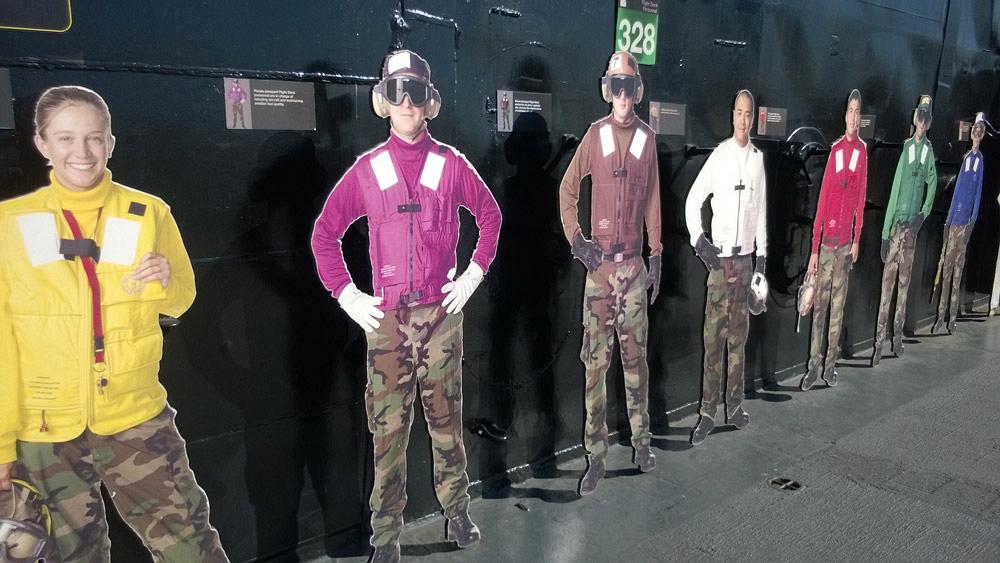
Figure 2
With one look at their uniform, those on deck of the USS Midway know exactly where people need to be and when.
MEC is not family-owned but instead has one of the largest ESOPs (employee stock ownership plans) in the country. “We have people driving fork trucks on the floor with more than $1 million in stock. I’m happy for that,” Kamphuis said.
“We do not invest for the short term,” he added. “We do have shareholders to answer to, but they’re not looking to see results this quarter. They’re looking to see what will be going on over the next decade.”
Economic Outlook: The Long View
Taking the long view is good business practice, especially considering the short-term economic jitters of recent months, peppered by the negative banter of a brutal presidential election season. That’s according to two economists who presented at the conference: Michael Gregory, deputy chief economist and head of U.S. economics at Chicago-based BMO Capital Markets, and Chris Kuehl, managing director at Lawrence, Kan.-based Armada Corporate Intelligence, who also serves as FMA’s economic analyst (see Figure 4).
Kuehl began by summing up his outlook for the next year: “We’re in sterling mediocrity. That’s not great, but it’s better than decline.”
Certain sectors will continue to put pressure on custom fabrication. The energy markets are suffering, as are metals, mining, and heavy equipment—all affected by the global slowdown, especially in China. Agriculture equipment-makers have been suffering but, according to Kuehl, may be on the rebound. “Farms need to keep operating, and equipment wears out,” he said.
The strong dollar is a factor, Kuehl said, but its effect on manufacturing may be less than many industry observers think. The dollar is rising because so much money around the world is moving stateside, mainly because of struggles in the rest of the world, including the BRIC (Brazil, Russia, India, and China) countries. So even if the dollar were for some reason lower, it still may not have a positive effect on U.S. manufacturing exports, considering the struggling economies around the world.
Overcapacity and excess inventory in the supply chain remain a challenge too. “We have an overabundance of inventory,” Kuehl said, adding that manufacturers ramped up significantly after the recession, made significant equipment investments, and as a result are sitting with a lot of capacity to fill.
Still, despite troubles in the commodity, heavy equipment, and energy sectors, other areas of the economy are shining bright. The automotive sector just finished a record year, and many expect that growth to continue (although some question whether automotive production has reached its peak). Transportation and trucking are doing well, as is the aerospace sector, which is reaping the benefits of low fuel prices.
These bright spots have created a rosy outlook that belies short-term worries. Kuehl reported that in February many metrics in the Credit Managers’ Index (CMI), which he compiles with the National Association of Credit Management, were trending positively (above 50).
As Kuehl explained, “The CMI tends to predict the PMI®,” or the Purchasing Managers Index from the Institute for Supply Management. And for the third month in a row, the CMI has been trending slightly upward.”
Still, as Gregory from BMO Capital Markets commented, it’s been years since the recession—aren’t we due for another one? Economists aren’t so sure, mainly because of two positive signs: job and wage growth. “Wages have been slow to respond thus far [to the gradual economic growth], but that is changing,” Gregory said. “Wages continue to go up … I’m bullish on the consumer sector. Real income is growing solidly by 4 percent, and we’ve got 3 percent growth in consumer spending.”
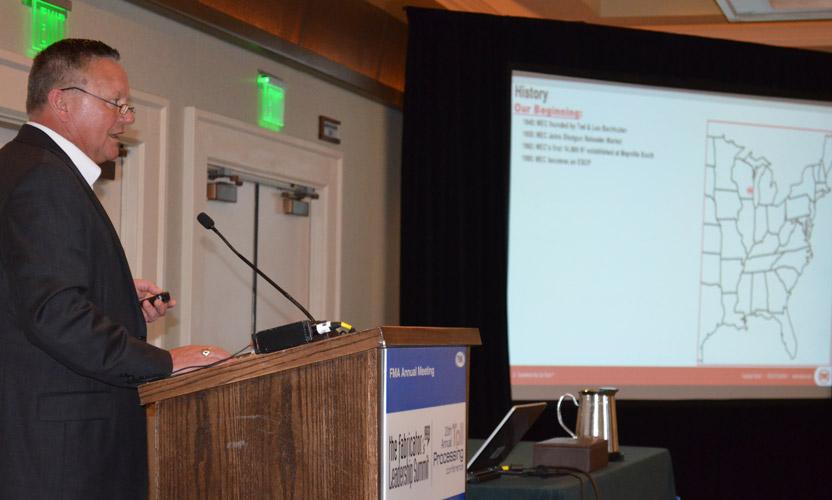
Figure 3
Bob Kamphuis, CEO of MEC Inc., The FABRICATOR’s Industry
Award winner for 2016, presented at the FMA
Annual Meeting in San Diego.
Quit and job turnover rates are rising too, more signs of a tightening labor market, Gregory said, which in turn leads to rising incomes and consumer spending.
Still, Kuehl ended with a broad disclaimer: “It’s almost impossible to make an accurate economic assessment in the U.S. simply because we have a $17 trillion economy. Canada has the same GDP as Texas. Argentina has the same GDP as Dallas.”
One commodity that’s affecting all metal manufacturers is, of course, metals. Metal fabricators, especially large ones, are reporting that customers are demanding price reductions based on the new (lower) metals price.
At the conference, Eric Klenz, managing director of metals, mining and investment banking at KeyBanc Capital Markets, said that he expects inventories at steel service centers will “normalize” during the latter part of this year. Still, China continues to produce steel even as the domestic economy slows. That overproduction represents excess steel capacity in the global market, plenty of which ends up in the U.S. Pending trade cases may put a halt to some of this, providing some price pressure relief for the domestic steelmakers.
Regardless, the metals and mining sector is the second-worst performer, behind energy, in terms of capital markets, Klenz said, adding that in 2015, metals and mining was the worst performer.
The Catapult
To succeed in this challenging environment, a fabricator needs both high technology (like the catapult on the aircraft carrier) and skilled employees (the pilot landing on deck) who work as a trained, constantly communicating team (the deck crew).
To make this happen, fabricators need the right information at the right time—and in the future, connected machines will play a large role in making this happen. That’s according to representatives from Amada, Bystronic, Mazak, MC Machinery Systems, TRUMPF Inc., and BLM Group.
The representatives sat on a technology panel that discussed Industry 4.0, the era of not just efficient but smart automation, with machines capable of communicating with each other to make adjustments in real time.
Panelists talked about the merits of machine communication with enterprise resourcing planning and production software; automating functions like nesting and the scheduling of blanking machines; and the high throughput of the fiber laser and its effect on throughput requirements at downstream operations, including bending.
Another industry panel asked a separate question: To automate or not to automate? It seems like a moot point. Common wisdom says that fab shops will automate or die. But will they? As panelists described, it really depends on customer demand and available labor.
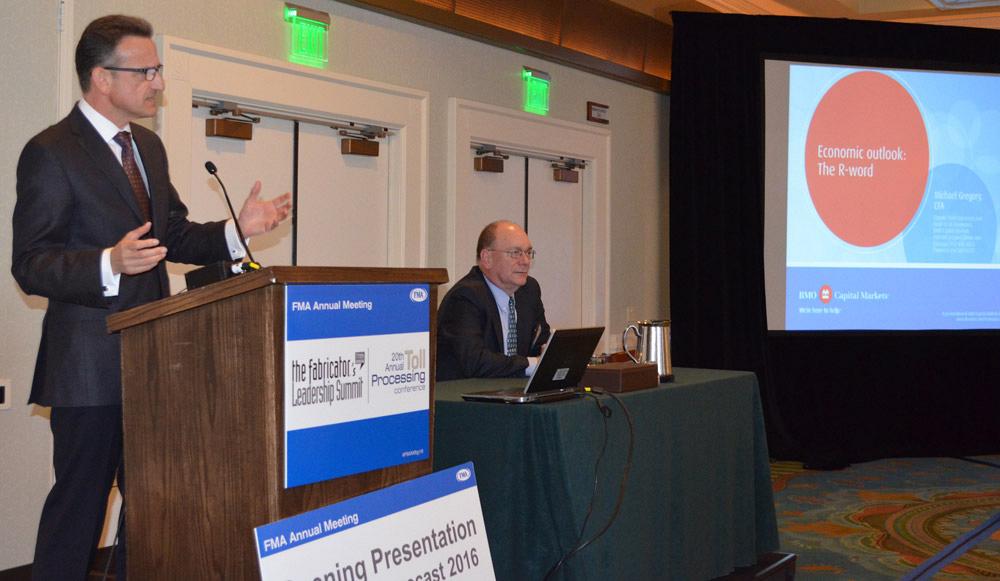
Figure 4
Michael Gregory of BMO Capital Markets (left) and
Chris Kuehl, FMA economic analyst, presented at The
FABRICATOR’s Leadership Summit.
Ronald Keizer, president of USA Dutch, a $4 million fab shop in Efland, N.C., said his shop participates in FMA’s “Financial Ratios & Operational Benchmarking Survey.” For two years running, his company has ranked near the top both in profitability and on-time delivery, and yet he said the company makes limited use of automation.
“We are laser-focused on on-time delivery,” he said, “and our culture has accepted and embraced that.”
Keizer said that, in effect, he uses labor to deal with demand variability. “It’s almost as if all your machines are automated. Wherever your bottleneck is, that’s what you work on at night.” He added that this model works for his company’s size, customer base, and local labor force, but it may not work for everyone.
The other shop executives on the panel—Gary Koester of Koester Metals Inc., Fremont, Ind.; Jon DeWys of DeWys Manufacturing Inc. in Marne, Mich.; John Axelberg of General Sheet Metal Works in South Bend, Ind.; and Mike Mueller of B & W Trailer Hitches, Humboldt, Kan.—come from larger organizations, and each has varying levels of automation.
Besides increased throughput and efficiency, some said that automation in many cases helped build a better work environment. DeWys described several custom systems, including one robotic hardware-insertion cell that came from the imagination of in-house engineers. Giving people opportunities to design such systems, he said, helps employee engagement. The fabricator isn’t just making parts; it’s designing entire manufacturing systems.
In a related panel, software experts from Exact, Global Shop Solutions, and ECi Software Solutions spoke on challenges of scheduling and improving on-time delivery. As the panelists described, good scheduling calls for, above all else, good information. This includes accurate routings, time and piece counts, and other transactional data.
Keith Stout, vice president of operations at Ace Metal Crafts, a custom stainless steel fabricator in Bensenville, Ill., described how his company now practices job sequencing—that is, working on one job from start to finish, all sequenced by the due date—using its ERP platform from ECi.
He compared the concept with a ride at Disney World. To get on a ride, you stand in line (regular order). Then you have people who skip the line (the expedited order). To manage all this isn’t easy, and key to making it happen has been scheduling what Stout called “concurrent sub-jobs.”
A job may require parts that are cut, sawed, deburred, and so on, and all the parts need to meet at the welding or assembly station at the right time. “How do we coordinate these unique sequences all at once? This is where our ERP system has really helped us.”
He conceded that job sequencing has created more complications in laser cutting. Operators manage sheet remnants continually. And some jobs require multiple material types and different gauges. “It’s no longer an ‘11-gauge day.’ It’s a ‘30 different material types day,’” he said. “That was our biggest challenge. But once we were able to get the laser to cut in sequence, work started to flow.”
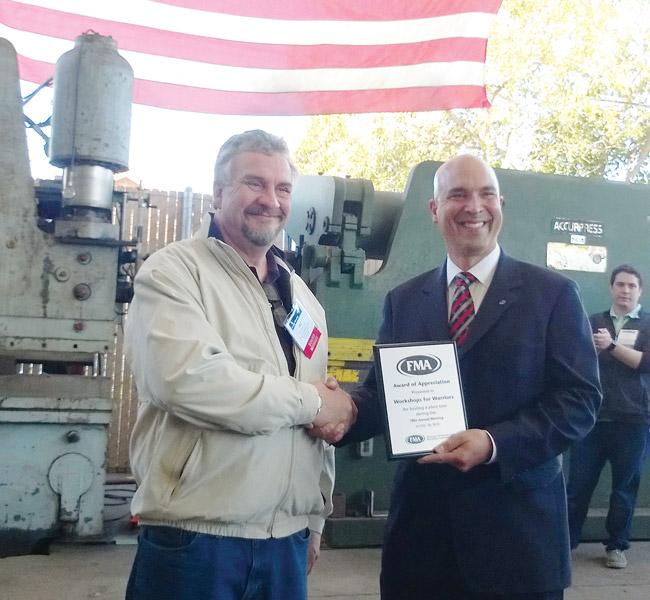
Figure 5
FMA board member Phil Meinczinger of Magnetic Analysis Corp. presented Hernán Luis y Prado, founder and president
of Workshops for Warriors, with a plaque of appreciation after a tour during the FMA Annual Meeting.
Another key component is bar coding parts. In the 1980s, Ace experimented with bar coding and yet had only two bar coding stations in the entire shop. Workers wasted time standing in line to scan in a job. Today the shop has a bar code scanner at nearly every workstation.
Making the Tailhook Catch
Software and equipment represent the “catapult” of metal fabrication, the technology necessary for a shop to take off and compete. But what about carrying out the mission and navigating back safely onto the aircraft carrier deck, ensuring the tailhook catches the cable at just the right time and in just the right way?
This takes skill and training, and nowhere was this more evident than when conference attendees toured Workshops for Warriors (www.workshop sforwarriors.org), a San Diego school that offers an accelerated program to train and certify veterans to enter the skilled trades (see Figure 5). Students do not pay tuition; they attend for free with the support of private and corporate donations. According to Amy Sage, development associate, the organization is about two years away from being eligible for coverage under the Post 9/11 GI Bill.
The school, which now has about 55 students, 45 percent of whom are on active duty, focuses on serving post 9/11 veterans between 18 and 34 years old. The goal is to transition these already highly engaged people into the civilian workforce. And the demand is certainly there; more than 500 applicants on the waiting list hope to enroll in future semesters.
The organization teaches students CAD/CAM, machinery repair and maintenance, CNC and manual machining and turning, as well as welding and fabrication. Since 2008 the organization has placed 100 percent of its graduates in full-time positions.Students can earn certifications and certificates from the National Institute for Metalworking Skills, the American Welding Society, as well as certifications from Mastercam and SolidWorks. Typical starting pay ranges from $18 to $34 an hour.
“When students leave here, they can have anywhere from five to 12 certifications,” said Sage.The school has numerous corporate supporters. Its donated equipment includes an advanced press brake and laser from Amada; press brakes from Betenbender; saws from HE&M Saw; a waterjet machine from Flow International; machining centers from Haas Automation; tooling from Snap-On, Starrett, and others; and software from SolidWorks and Mastercam. Reliance Steel & Aluminum Co. donated a mobile classroom, and FMA’s Nuts, Bolts & Thingamajigs foundation provided funding to build a concrete foundation for the school’s laser cutting machine.
“Our young students have multiple job opportunities across the United States,” Sage said. “They are just at the beginning of their careers, and they will be the ones running the manufacturing industry.”
For more on the FMA Annual Meeting, visit www.fmanet.org/annualmeeting. The next FMA Annual Meeting will be held in New Orleans March 8-10, 2017. For updates, visit www.fmanet.org/annualmeeting
FMA Annual Meeting keynote: Growth and opportunities
When Jim Rogowski of TRUMPF Inc. introduced Gene Marks, he said Marks was a double major in history and particle physics and has run numerous Ironman competitions. He then paused. “That’s all a lie. Gene Marks is an accountant.”
That’s a telltale sign that the keynote speaker for the FMA Annual Meeting doesn’t take himself too seriously. But as a frequent commentator on news channels, a columnist for Forbes, a book author, and a consultant who meets thousands of company leaders every year, Marks does take business seriously.
So what separates successful business leaders from the crowd? “It’s not just being innovative,” Marks said. “They’re always looking ahead.”
Looking ahead, Marks pointed out that labor will continue to be one of the greatest costs for businesses. To that end, he pointed out several areas in which business leaders can manage costs and make the most of their most valuable resource.
- Watch out for increasing health care costs. Premiums for plans under the Affordable Care Act are on the rise. “Smart businesspeople are watching this carefully,” he said. To combat rising health care costs, companies can consider alternatives such as self-insurance and high-deductible plans.
- Watch out for increases in minimum wage and paid time off requirements. The minimum wage is set to rise, and an increase in the minimum wage will affect all wages. “A $15-an-hour minimum wage is coming,” Marks said. Required paid time off requirements are rising too. Starting in 2017, federal contractors must provide one hour of paid sick leave for every 30 hours worked. New rules in the Fair Labor Standards Act also change who is eligible for overtime pay.
- Watch out for tax breaks, and take advantage of them. Section 179 (accelerated depreciation of equipment) and the R&D tax break have been made permanent.
- Watch out for smart technologies, particularly when it comes to employee communication and engagement. For instance, business owners and managers are communicating with employees through Google Hangouts on Air, a video service that archives content on YouTube, and sending messages via Slack.
About the Authors

Dan Davis
2135 Point Blvd.
Elgin, IL 60123
815-227-8281
Dan Davis is editor-in-chief of The Fabricator, the industry's most widely circulated metal fabricating magazine, and its sister publications, The Tube & Pipe Journal and The Welder. He has been with the publications since April 2002.

Tim Heston
Senior Editor
2135 Point Blvd
Elgin, IL 60123
815-381-1314
Tim Heston, The Fabricator's senior editor, has covered the metal fabrication industry since 1998, starting his career at the American Welding Society's Welding Journal. Since then he has covered the full range of metal fabrication processes, from stamping, bending, and cutting to grinding and polishing. He joined The Fabricator's staff in October 2007.
Related Companies
subscribe now

The Fabricator is North America's leading magazine for the metal forming and fabricating industry. The magazine delivers the news, technical articles, and case histories that enable fabricators to do their jobs more efficiently. The Fabricator has served the industry since 1970.
start your free subscription- Stay connected from anywhere

Easily access valuable industry resources now with full access to the digital edition of The Fabricator.

Easily access valuable industry resources now with full access to the digital edition of The Welder.

Easily access valuable industry resources now with full access to the digital edition of The Tube and Pipe Journal.
- Podcasting
- Podcast:
- The Fabricator Podcast
- Published:
- 04/16/2024
- Running Time:
- 63:29
In this episode of The Fabricator Podcast, Caleb Chamberlain, co-founder and CEO of OSH Cut, discusses his company’s...
- Trending Articles
Capturing, recording equipment inspection data for FMEA

Tips for creating sheet metal tubes with perforations

Are two heads better than one in fiber laser cutting?

Supporting the metal fabricating industry through FMA

Omco Solar opens second Alabama manufacturing facility

- Industry Events
16th Annual Safety Conference
- April 30 - May 1, 2024
- Elgin,
Pipe and Tube Conference
- May 21 - 22, 2024
- Omaha, NE
World-Class Roll Forming Workshop
- June 5 - 6, 2024
- Louisville, KY
Advanced Laser Application Workshop
- June 25 - 27, 2024
- Novi, MI

























